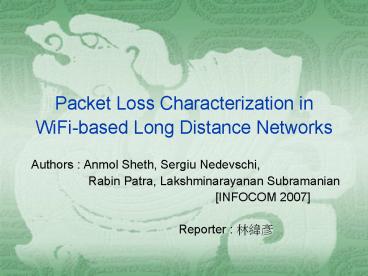Packet Loss Characterization in WiFibased Long Distance Networks
1 / 29
Title:
Packet Loss Characterization in WiFibased Long Distance Networks
Description:
Packet Loss Characterization in WiFi-based Long Distance Networks. Authors : Anmol Sheth, Sergiu Nedevschi, Rabin Patra, Lakshminarayanan Subramanian ... –
Number of Views:49
Avg rating:3.0/5.0
Title: Packet Loss Characterization in WiFibased Long Distance Networks
1
Packet Loss Characterization in WiFi-based Long
Distance Networks
- Authors Anmol Sheth, Sergiu Nedevschi,
- Rabin Patra, Lakshminarayanan Subramanian
- INFOCOM 2007
- Reporter ???
2
Motivation
- Do some measurements for understanding how WiLD
(WiFi-based Long Distance) networks perform in
practice - Analyze the loss variability across time
- Explore the solution and propose some methods to
mitigate loss
3
Outline
- Methodology
- Loss Variability analysis
- Remedies
- Conclusion
- Novelty Strength
- Weakness
4
Methodology
- Measurements on a WiLD network testbed comprising
of links in both rural and urban environment. - Use wireless channel emulator (Spirent 5500) to
study each source of packet loss in isolation.
5
Methodology (cont.)
- Testbed setup
- 802.11 a/b/g
- CBR UDP traffic streams
- Turn off MAC-layer ACKs and set the maximum
retries limit to zero - Modify Atheros madwifi driver to pass up
frames with CRC and PHY errors
6
Methodology (cont.)
- Channel losses
- External WiFi interference
- External non-WiFi interference
- Multipath interference
- 802.11 protocol-induced losses
- Timeouts due to propagation delay
- Breakdown of CSMA over long distances
7
Channel losses
- External WiFi interference
- External non-WiFi interference
- Multipath interference
8
External WiFi interference
- Any WiFi traffic that is not a part of the
primary WiLD link is categorized as external WiFi
interference
experiment
emulation
9
External WiFi interference
- Effect of hidden terminals in WiLD networks
10
External WiFi interference
- Effect of relative power and rate of external
interference
Emulation result
11
Channel losses
- External WiFi interference
- External non-WiFi interference
- Multipath interference
12
External non-WiFi interference
- Other devices that share the 2.4 GHz band.
- microwave
- cordless phone
- Wide-band noise
- Result no significant correlation between noise
and loss rate.
13
Channel losses
- External WiFi interference
- External non-WiFi interference
- Multipath interference
14
Multipath interference
- Comparing to mesh network deployment, there are
two factors contributing to lower delay spreads
in the WiLD networks. - long distance between two end hosts
- line-of-sight deployment of the nodes
Delays between a primary and secondary
reflection at midway and quarter-way point.
15
802.11 protocol-induced losses
- Link layer recovery mechanism
- Breakdown of CSMA
16
Link layer recovery mechanism
- The 802.11 MAC uses a simple stop-and-wait
protocol, when MAC ACKs are enabled, the sender
has to wait for an ACK after each transmission,
and this leads to decreasing channel utilization
with increasing link distance.
Emulation result
17
Breakdown of CSMA
- On longer distance links, it is possible that the
two nodes will begin transmission within the
window defined by the propagation delay. - The throughput of the WiLD link degrades as the
distance is increased.
18
Main Result
19
Loss Variability
- Burst-Residual Separation
- Burst
- time-periods with sharp spikes in the loss rate
- Residual
- the losses that constantly occur in the
underlying channel over time.
0
1
P1
P2
Loss Variability distribution
Burst
Residual
20
Burst characteristic
- Short burst
- majority of the bursts to be short bursts that
last for less than 0.3s - Long burst
- a single long burst is followed by a string of
other long bursts separated by short
time- periods (in the order of a few seconds).
21
Residual characteristic
- The residual loss distribution is stationary over
hourly time scales - The residual loss rate on any link remains
roughly constant over a few minutes even in the
presence in short bursts during such periods.
22
Remedies
- Frequency Channel Adaption
- Rate Adaptation
- Adaptive Forward Error Correction
23
Frequency Channel Adaption
- The advantages of channel switching could be
significant in presence of long or high-loss
bursts
Simulation result
24
Rate Adaptation
- The increased transmission time of the frame
increases the probability of a collision with the
external traffic.
Simulation result
25
Adaptive Forward Error Correction
- At the end of each time slot the receiver informs
the transmitter of the loss observed in the
previous slot. Based on this link information,
the transmitter adjusts the redundancy for the
next round.
Simulation result
26
Conclusion
- Most of the losses arise due to external WiFi
interference on same and adjacent channels. - The loss due to external WiFi interference
depends on the relative power level between the
primary and external traffic, their channel
separation, and the rate of external
interference.
27
Novelty Strength
- The loss rate is strongly related to the amount
of external traffic received on the same and
adjacent channels in contrast to the
omni-directional antennas used in the mesh
networks deployment. - From the emulation traces they observed that
almost 100 of the lost frames contained CRC
errors.
28
Weakness
- Switching the frequency channel could mitigate
interference however, it is not always possible
to switch a frequency channel in a large scale
deployment. - Most of the 802.11 radios have built in
rate-adaptation algorithms which selects a lower
rate with feasible encoding on experiencing high
loss.
29
Thank you!































